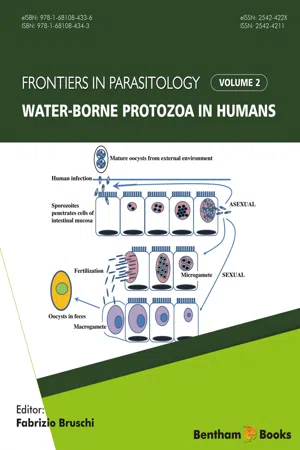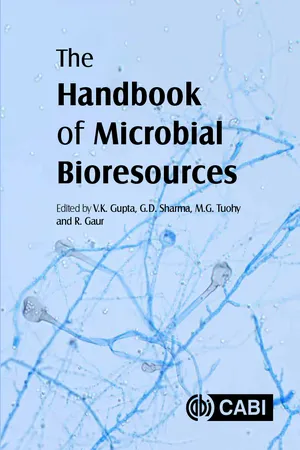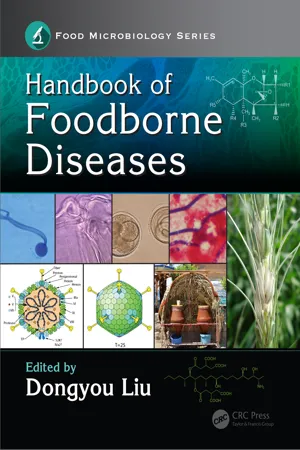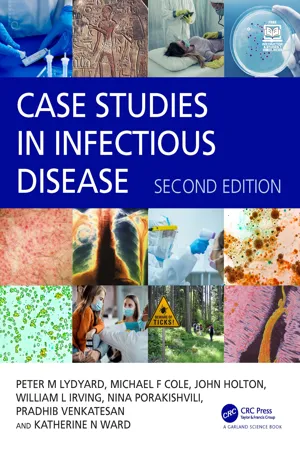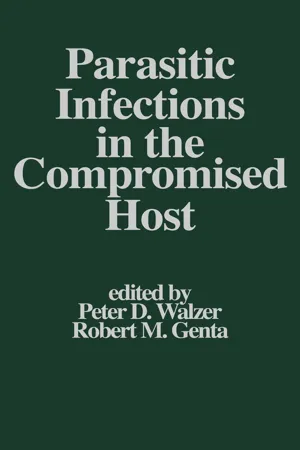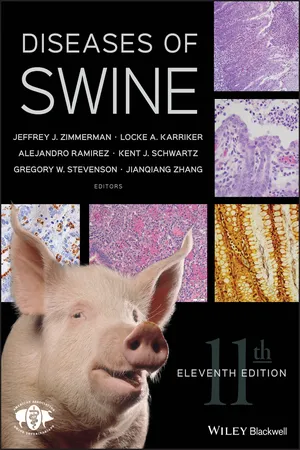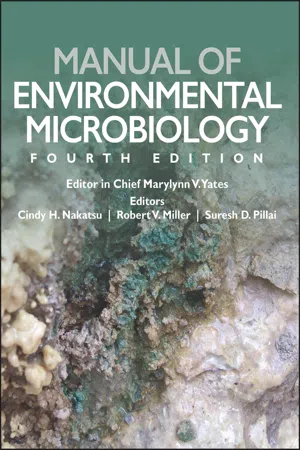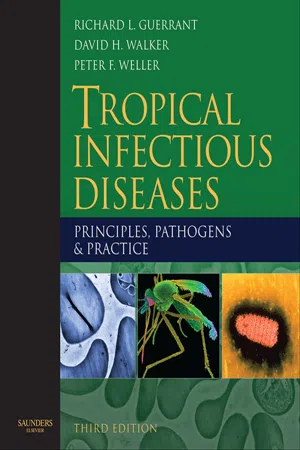Biological Sciences
Giardia
Giardia is a genus of parasitic microorganisms that can cause gastrointestinal illness in humans and animals. The most common species, Giardia lamblia, is a leading cause of waterborne disease worldwide. Infection occurs through the ingestion of contaminated food or water, and symptoms may include diarrhea, abdominal cramps, and nausea.
Written by Perlego with AI-assistance
Related key terms
Related key terms
1 of 4
Related key terms
1 of 3
10 Key excerpts on "Giardia"
- eBook - ePub
- Fabrizio Bruschi(Author)
- 2017(Publication Date)
- Bentham Science Publishers(Publisher)
Giardia and GiardiasisINTRODUCTION
Giardia intestinalis, also known as Giardia duodenalis or Giardia lamblia, is aunicellular protozoan parasite that infects the upper intestinal tract of humans and animals [1 ]. The disease, Giardiasis, manifests in humans as a bout of acute diarrhea that can develop to a chronic stage but the majority of infections remain asymptomatic [2 , 3 ]. Giardiasis has a global distribution with 280 million cases reported annually, with its impact being more pronounced in the developing world, where it is usually associated with poor socioeconomic conditions [4 ]. Children, elderly people and immunocompromised individuals are the most affected by the disease [5 - 7 ]. In children specifically, effects on growth, nutrition and cognitive function have been reported [8 - 10 ]. Currently, it has been suggested that Giardiasis could predispose for chronic gastrointestinal disorders such as irritable bowel syndrome (IBS) [11 , 12 ]. In 2004, Giardiasis was recognized by the World Health Organization (WHO) as a neglected disease associated with poverty, impairing development and socio-economic improvements [13 ]. Because Giardiasis adds to the global microbial disease burden, an initiative was instigated to implement a comprehensive approach for control and prevention [13 ]. One area of focus is the potential spread of Giardiasis via food and food handling [14 , 15 ], daycare settings [16 , 17 ], travel to endemic areas and close human contact [18 - 20 ]. Potential transmission of Giardiasis from animals to humans (i.e. zoonosis) has been also the subject of extensive research over the years. Wildlife accessibility to water used for drinking and recreational purposes, as well as living in proximity with animals, have been identified as risk factors associated with zoonosis [21 - 23 ]. Another body of research addressed the effect of Giardiasis on livestock. Not only transmission in livestock but also economic losses associated with poor growth, weight loss, reduced productivity and even death of animals [24 - 28 - eBook - ePub
- Vijai Kumar Gupta, Gauri Dutt Sharma, Maria G Tuohy, Rajeeva Gaur(Authors)
- 2016(Publication Date)
- CAB International(Publisher)
14 Giardia and Giardiasis: an Overview of Recent DevelopmentsSandipan GangulyNational Institute of Cholera and Enteric Diseases, Kolkata, India*and Dibyendu RajAbstractGiardia lamblia is one of the most common protozoan enteric pathogens that inhabits the upper small intestine of humans and several other vertebrates and causes Giardiasis. Global prevalence of Giardiasis has been estimated to be 300 million cases annually. To adapt in environments both inside and outside the small intestine of the host, this protozoan parasite undergoes significant developmental changes during its life cycle. It has been confirmed that G. lamblia has become drug resistant and biochemical studies have been undertaken to investigate the cause of resistance. This chapter focuses on the most current findings regarding the important advances in understanding the molecular mechanisms that regulate the antigen switching process, including oxidative stress and expressional modifications in Giardia, and potential drug targets for the treatment of Giardiasis are discussed.14.1 Introduction
The micro-aerotolerant Giardia lamblia, a unicellular, gastrointestinal flagellated protozoan causes one of the most frequent parasitic infections worldwide (Adam, 1991 ). It lacks conventional mitochondria, Golgi body and peroxisomes. In 2002 an estimated 280 million symptomatic human infections were reported every year (Lane and Lloyd, 2002 ) but more recently this has risen to 300 million cases annually (Morrison et al., 2007 ). The symptoms of Giardiasis are watery diarrhoea, abdominal pain, irritable bowel syndrome, nausea, vomiting, weight loss and the symptoms appear 6–15 days after infection (Farthing, 1997 ). The disease symptoms have been observed to be more profound in malnourished children and in immunodeficient individuals. Metronidazole or other nitroimidazoles are the common treatment options. Giardia species cannot invade the gut and it secretes no well-known toxin but recent data suggests that Giardia increases intestinal permeability by augmenting apoptosis of the inner cell lining of the intestine (Singer and Nash, 2000 ; Scott et al., 2002 ). Due to its potential as a zoonotic pathogen, farm animals get infected hampering the economic yield (O’Handley et al., 2001 ). Even though this infection is chronic nearly half of cases are asymptomatic and infection subsides without drug treatment (Farthing, 1997 ). It has been put forward that certain gastrointestinal disorders like irritable bowel syndrome can be related to a previous Giardia infection (Hanevik et al., 2009 - eBook - ePub
- Dongyou Liu(Author)
- 2018(Publication Date)
- CRC Press(Publisher)
57 Giardia R. Calero-Bernal and D. CarmenaContents 57.1Introduction 57.2Taxonomy 57.3Structure 57.4Life Cycle 57.5Epidemiology 57.6Clinical Disease and Pathogenesis 57.7Laboratory Diagnosis 57.8Treatment 57.9Prevention 57.10Future Perspectives References57.1IntroductionMembers of the genus Giardia are ubiquitous flagellated protozoa that infect the intestinal tracts of a wide range of vertebrates including mammals, amphibians, and birds. Among them, G. duodenalis is the etiological agent of Giardiasis, a major cause of gastrointestinal illness estimated to affect about 200 million people each year only in developing countries.1 Although not formally considered a neglected tropical disease, Giardiasis belongs to the group of poverty-related infectious diseases that impair the development and socioeconomic potential of infected individuals in endemic areas. G. duodenalis is also a significant contributor to the burden of diarrheal disease in developed countries.2 The infection is transmitted via the fecal-oral route after ingestion of cysts either indirectly through contaminated water, food, or fomites, or directly through contact with infected individuals or animals. Host (age, immune status, concomitant intestinal microbiota, and diet) and parasite (genotype, virulence, resistance to chemotherapy, and ability to evade immune response) determinants will define the outcome of the infection, whose clinical manifestations range from asymptomatic carriage, self-limited acute diarrhea, and chronic infection.3 In recent years, molecular methods including polymerase chain reaction (PCR)–based assays, sequencing, and phylogenetic analyses have made a substantial contribution to our understanding not only of the epidemiology, but also the taxonomy, evolutionary history, diagnostics, and pathogenesis of G. duodenalis - eBook - ePub
- Peter Lydyard, Michael Cole, John Holton, Will Irving, Nino Porakishvili, Pradhib Venkatesan, Kate Ward(Authors)
- 2023(Publication Date)
- CRC Press(Publisher)
WHAT IS THE CAUSATIVE AGENT, HOW DOES IT ENTER THE BODY, AND HOW DOES IT SPREAD A) WITHIN THE BODY AND B) FROM PERSON TO PERSON? ■ Giardia is a protozoan flagellate. It has two stages – a trophozoite and a cyst with a highly resistant wall. ■ Giardia consists of six species. Only one species infects humans and this is variously referred to as G. intestinalis, lamblia or duodenalis. There are at least eight genotypes or assemblages (A-H). Only A and B are human pathogens, with B being the most frequent globally. Other genotypes are seen in other mammals and birds. ■ The main infectious stage is the cyst; cysts are ingested in contaminated water or food. They lose their cell wall in the duodenum and emerge as trophozoites, which attach to the intestinal wall through their ventral “sucking” disk and feed. They colonize large areas of epithelial surface. They rarely invade the epithelium and spread systemically. They become encysted again and both trophozoites and cysts pass out of the body in stools. ■ Contamination of public drinking supplies has led to Giardiasis epidemics. When children become infected, up to 25% of their family members also become infected. Individuals can shed cysts in their feces and remain symptom-free. Sexual transmission of Giardia has been described in homosexual males. ■ Giardia is found in a wide variety of different animal species and has been regarded as a zoonosis, although there is little evidence for animals being a significant source of human Giardiasis. ■ Giardiasis is one of the most common causes of diarrhea worldwide. There are around 280 million cases a year. It is more commonly found in children where, in developing countries, it is estimated that up to 20% are infected. ■ Giardia is widespread in the US, with a prevalence of an estimated 1.2 million with the majority not identified due to the carrier being asymptomatic. Infection is most common in late summer and early fall due to outdoor water activities - eBook - ePub
- Peter D. Walzer, Robert M. Genta(Authors)
- 2020(Publication Date)
- CRC Press(Publisher)
G. lamblia and the disease it causes have occurred since van Leeuwenhoek's insightful report to the Royal Society.II. The OrganismA. Life Cycle and Epidemiology
Giardia lamblia is a unicellular protozoan parasite that exists in two forms: the dormant cyst, which transmits disease to the host, and the motile flagellated trophozoite, which causes disease. There is no intermediate developmental stage outside the gastrointestinal tract of the host. Unlike other protozoan parasites such as Toxoplasma gondii (chapter 4 ), Leishmania spp., Trypanosoma spp., Malaria spp., or the coccidian protozoan Cryptosporidium (Chapter 5 ), G. lamblia is an extracellular protozoan. In this respect it resembles Entamoeba histoloytica (Chapter 7 ).The clinically relevant phase of the parasite's life cycle appears to begin in the stomach (Fig. 1 ). Here normal physiological conditions including the acidity, oxidation-reduction potential, temperature, and presence of carbon dioxide are similar to the in vitro conditions that facilitate excystation (2 ,3 ). However, since trophozoites do not survive in an acidic environment, excystation likely is completed in the more alkaline proximal small intestine where colonization occurs. Here the trophozoite, which reproduces by binary fission, evades enzymatic degradation by unknown mechanisms and may survive for long periods of time. In view of the ability of bile and biliary lipids to promote trophozoite growth (4 ,5 ), apparently through enhanced membrane lipid (lecithin) uptake (6 ), the bile-rich proximal small intestine is a particularly suitable environment for colonization. In addition, luminal proteases in the proximal small intestine may participate in a novel host-parasite interaction by activating a lectin in G. lamblia most specific for mannose-6-phosphate, which then facilitates the binding of trophozoites to the glycosylated microvillous membrane of the intestinal surface (7 ). Between the proximal small intestine and colon trophozoites undergo encystation, a process augmented in vitro by primary bile salts (242 - eBook - ePub
- Lynne Shore Garcia(Author)
- 2016(Publication Date)
- ASM Press(Publisher)
62 ).Characterization of Giardia Isolates. Isoenzyme studies, designed primarily to assist in organism identification and classification, have also provided additional information regarding pathogenicity, implication in waterborne outbreaks, and human disease. In one study in which isoenzyme patterns of 32 Giardia isolates obtained from both humans and animals were examined, there was no obvious correlation between clinical symptoms and isoenzyme patterns. Isolates from asymptomatic individuals were found in the same zymodemes (isoenzyme groups) as were isolates from symptomatic hosts. This study also confirmed previous observations regarding genetic heterogeneity and demonstrated significant differences between isolates from within a single region and other widely separated geographic locations (2 ). Australian data on two Giardia demes indicated that both appeared to be pathogenic and were derived from children with similar chronic symptoms (13 ).Various studies have published data suggesting that zoonotic transmission between humans and animals is, at times, more likely or less likely to occur (5 , 51 , 63 , 64 ).Dientamoeba fragilisDientamoeba fragilis was first seen in 1909 but was not described until 1918. In 1940, Dobell recognized the close morphologic similarities between D. fragilis and Histomonas meleagridis , the ameboflagellate parasite of turkeys. A key scientific advance was made in 1934 when Tyzzer reported that H. meleagridis is transmitted in the eggs of Heterakis , the cecal worm of chickens and turkeys, a fact that has relevance to the life cycle of D. fragilis (1 , 65 ). On the basis of electron microscopy studies, D. fragilis has been reclassified as an ameboflagellate rather than an ameba and is closely related to Histomonas and Trichomonas spp. (66 ). It has a cosmopolitan distribution, and past surveys demonstrate incidence rates of 1.4 to 19%. Much higher incidence figures have been reported for mental institution inmates, missionaries, and Native Americans in Arizona. D. fragilis tends to be common in some pediatric populations, and incidence figures are higher for patients younger than 20 years in some studies. Currently, it is in the phylum Parabasala, class Trichomonadea, family Trichomonadidae - eBook - ePub
- Jeffrey J. Zimmerman, Locke A. Karriker, Alejandro Ramirez, Kent J. Schwartz, Gregory W. Stevenson, Jianqiang Zhang(Authors)
- 2019(Publication Date)
- Wiley-Blackwell(Publisher)
Trophozoites are flagellated, pyriform‐shaped protozoa that attach to the brush border of cells lining the small intestine where they absorb nutrients and multiply by binary fission (Figure 66.8). Trophozoites encyst in the small or large intestine and pass in the feces as environmentally resistant cysts. Freshly excreted cysts are immediately infectious and can remain infectious under moist and cool conditions for weeks. Trophozoites excreted in feces do not survive outside the body. Giardia is transmitted by ingestion of food or water contaminated with cysts. Figure 66.8 Life cycle of Giardia. In the United States, no association was found between Giardia infections and clinical illness in pigs (Xiao et al. 1994). Likewise, on European farms, no clinical signs were associated with the presence of Giardia in pigs (Petersen et al. 2015). Detection of motile trophozoites (10–20 μm long) can be seen in saline suspensions of loose or diarrheic feces. Ovoid to ellipsoid cysts (9–15 μm long) are best detected after concentration in feces using zinc sulfate flotation (specific gravity 1.18). Sucrose and sodium chloride flotation media are effective but hypertonic, distorting cysts if examination is not made quickly. Because cysts might be excreted intermittently, multiple fecal samples should be collected and examined at intervals within a week. Assemblages are determined based on genetic markers. The role of swine and other domestic animals as sources for G. duodenalis in humans is unclear. Giardia infections have been reported in pigs in all age groups from nursing piglets to boars and sows in the United States, Canada, Europe, Australia, Africa, and Asia with the prevalence ranging between 0.1 and 20% (Armson et al. 2009). In Ohio Giardia was detected in 8.3% of pre‐weaned piglets, 2.6% of post weaned pigs, and 1.5% of sows (Xiao et al. 1994) - eBook - ePub
- John A. Walker-Smith(Author)
- 2013(Publication Date)
- Butterworth-Heinemann(Publisher)
It is a biphasic parasite with trophozoite and cystic stages. It has four pairs of flagellae and a sucker disc. As a trophozoite it may infest the proximal small intestine in children and may be found in the glandular crypts of the duodeno-jejunal mucosa. Significant mucosal damage, usually partial villous atrophy but sometimes a flat mucosa, has been demonstrated in infestations with this parasite. However, the mucosa may sometimes be morphologically normal even when the parasite is present in the lumen. In fact, Ament and Rubin (1972) have shown a patchy mucosal abnormality in Giardiasis by demonstrating within the small intestine of one child, by serial biopsies along the length of the small intestine, that the mucosa can vary from a normal appearance to one that is severely abnormal. Figure 8.1 Appearance of Giardia lamblia under the light microscope (trophozoite). Figure 8.2 Scanning electron microscope appearance of single Gardia lamblia. × 2700. (Reproduced by kind permission of Phillips.) Giardia lamblia also exists as a tough, chitin-walled, oval cyst which enables it to survive for several months in water or soil. This cyst is the major infective form. It is transmitted either via contaminated food or water, or directly from person-to-person. As few as ten cysts may be sufficient to cause human infestation (Rendtorff, 1954) when predisposing factors such as infancy, gastric hypoacidity, immune deficiency and malnutrition are present. This is an extremely small fraction of the millions excreted daily by an infested person. Excystation has now been achieved in vitro (Rice and Schaefer, 1981). Exposure initially to low pH followed by pancreatic juice is a major stimulant for excystation and this presumably is what happens in vivo after ingestion - eBook - ePub
- Cindy H. Nakatsu, Robert V. Miller, Suresh D. Pillai(Authors)
- 2016(Publication Date)
- ASM Press(Publisher)
Vet Parasitol 182 : 70–78.[PubMed] [CrossRef]24. Lasek-Nesselquist E, Welch DM, Sogin ML . 2010. The identification of a new Giardia duodenalis assemblage in marine vertebrates and a preliminary analysis of G. duodenalis population biology in marine systems. Int J Parasitol 40 : 1063–1074.[PubMed] [CrossRef]25. Yoshida N, Tyler KM, Llewellyn MS . 2011. Invasion mechanisms among emerging food-borne protozoan parasites. Trends Parasitol 27 : 459–466.[PubMed] [CrossRef]26. Hunter PR, Hughes S, Woodhouse S, Nicholas R, Syed Q, Chalmers RM, Verlander NQ, Goodacre J . 2004. Health sequelae of human cryptosporidiosis in immunocompetent patients. Clin Infect Dis 39 : 504–510.[PubMed] [CrossRef]27. Clifford C, Crook D, Conlon C, Fraise A, Day D, Peto T . 1990. Impact of waterborne outbreak of cryptosporidiosis on AIDS and renal transplant patients. Lancet 335 : 1455–1456.[PubMed] [CrossRef]28. U.S. EPA . 1997. Cryptosporidiumand Giardia in water by filtration/IMS/FA. Draft method 1622. EPA-821-R-97-023. Office of Research and Development, U.S. Government Printing Office, Washington, DC.29. Petry F, Jakobi V, Tessema TS . 2010. Host immune response to Cryptosporidium parvum infection. Exp Parasitol 126 : 304–309.[PubMed] [CrossRef]30. Wobus CE, Karst SM, Thackray LB, Chang K-O, Sosnovtsev SV, Belliot G, Krug A, Mackenzie JM, Green KY, Virgin HW IV . 2004. Replication of norovirus in cell culture reveals a tropism for dendritic cells and macrophages. PLoS Biol 2 : e432.[PubMed] [CrossRef]31. Ryu H, Abbaszadegan M . 2008. Long-term study of Cryptosporidium and Giardia occurrence and quantitative microbial risk assessment in surface waters of Arizona in the USA. J Water Health 6 : 263–273.[PubMed] [CrossRef]32. Smith H, Rose J . 1990. Waterborne cryptosporidiosis. Parasitol Today 6 : 8–12.[PubMed] [CrossRef]33. Gold D, Smith HV . 2002. Pathogenic Protozoa and Drinking Water , pp. 143–162. In Palumbo F, Ziglio G, Beken AV (eds), Detection Methods for Algae, Protozoa and Helmints in Fresh and Drinking Water - Richard L. Guerrant, David H. Walker, Peter F. Weller(Authors)
- 2011(Publication Date)
- Saunders(Publisher)
Scand J Infect Dis . 1997;32:48.122 Chen XM, Keithly JS, Paya CV, et al. Cryptosporidiosis. N Engl J Med . 2002;346:1723.123 Astiazaran-Garcia H, Espinosa-Cantellano M, Castanon G, et al. Giardia lamblia : effect of infection with symptomatic and asymptomatic isolates on the growth of gerbils (Meriones unguiculatus ). Exp Parasitol . 2000;95:128.124 Paintlia AS, Descoteaux S, Spencer B, et al. Giardia lamblia groups A and B among young adults in India. Clin Infect Dis . 1998;26:190.125 Sahagun J, Clavel A, Goni P, et al. Correlation between the presence of symptoms and the Giardia duodenalis genotype. Eur J Clin Microbiol Infect Dis . 2008;27:81.126 Haque R, Mondal D, Karim A, et al. Prospective case-control study of the association between common enteric protozoal parasites and diarrhea in Bangladesh. Clin Infect Dis . 2009;48:1191.127 Ajjampur SS, Sankaran P, Kannan A, et al. Giardia duodenalis assemblages associated with diarrhea in children in South India identified by PCR-RFLP. Am J Trop Med Hyg . 2009;80:16.128 Homan WL, Mank TG. Human Giardiasis: genotype linked differences in clinical symptomatology. Int J Parasitol . 2001;31:822.129 Gelanew T, Lalle M, Hailu A, et al. Molecular characterization of human isolates of Giardia duodenalis from Ethiopia. Acta Trop . 2007;102:92.130 Cedillo-Rivera R, Darby JM, Enciso-Moreno JA, et al. Genetic homogeneity of axenic isolates of Giardia intestinalis derived from acute and chronically infected individuals in Mexico. Parasitol Res . 2003;90:119.131 Robertson LJ, Forberg T, Hermansen L, et al. Molecular characterisation of Giardia isolates from clinical infections following a waterborne outbreak. J Infect . 2007;55:79.132 Yason JA, Rivera WL. Genotyping of Giardia duodenalis isolates among residents of slum area in Manila, Philippines. Parasitol Res
Index pages curate the most relevant extracts from our library of academic textbooks. They’ve been created using an in-house natural language model (NLM), each adding context and meaning to key research topics.
Explore more topic indexes
Explore more topic indexes
1 of 6
Explore more topic indexes
1 of 4
